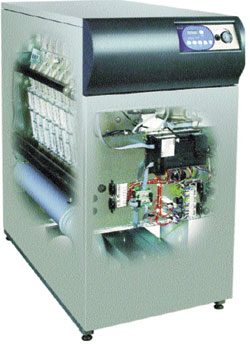Graham Williamson, business director of commercial heating at Ideal Boilers, discusses the impact Part L2A and L2B of the Building Regulations for non-domestic buildings have had on the industry since they were introduced in April.
WITHOUT doubt, the revision to Part L of the Building Regulations is one of the single biggest issue the commercial and industrial heating industry has been faced with for many years. However, while it is clear that the primary drive for the changes is to improve the energy performance standards in buildings and reduce carbon emissions, the introduction has not gone smoothly.
As with all compliance documents, the revisions to Part L were very detailed and comprehensive in content. This complexity has led to some confusion over what is actually required to comply, with installers and specifiers not fully appreciating what is required of them, and more importantly, what the regulations actually mean to system design criteria.
Confusion has been further compounded by delays and the inevitable inaccuracies to the published document, as the approved version of the Part L had to be rushed through to meet the April deadline, well before any accompanying guidance documents could be produced.
This left the industry with no time at all to get up-to-speed and work out how to comply.
It is this approach that has caused concern with many industry bodies.
As with the Part L1 document for the domestic sector, introduced in 2005, it has been left to manufacturers, trade associations and the media to make sense of the changes and communicate the essential information in order to raise awareness of the impact they will have for the sector.
Despite these hurdles, the good news is that information is now readily accessible. Supporting information such as ICOM’s compliance guide contains a condensed version of Part L2 requirements and has been specifically designed to simplify the information as much as possible for installers and designers alike.
In line with these amendments to Building Regulations the industry has, during the last six months seen demand for energy efficient products increase, with industry experts now predicting that demand for HE (high efficiency) boilers could be as high as 65% by the end of the year. Manufacturers have also responded to these changes with new products and range extensions that meet and exceed legislation to offer installers and specifiers more choice and options.
Ideal Boilers is constantly looking at ways of improving its product and service offering. It has responded to the updated Building Regulations by introducing the Imax xtra range. Launched in April this year to offer greater choice for commercial and industrial heating applications, the floor standing Imax xtra is manufactured to meet the needs of the UK market and exceeds legislation, while building on the success of the Imax W and Imax Plus range of high efficiency condensing boilers.
However, it must also be recognised the technological advancements that have been made in developing condensing technology for HE commercial boilers has virtually reached its technological limit. In the near future, it will be increasingly difficult to make any significant increases in the efficiency of these appliances. As an industry, it is therefore essential we understand that to achieve an ongoing reduction in carbon emissions greater emphasis needs to be placed on how a commercial heating system operates.

Ideal's Imax extra
But while the Building Regulations have demanded that manufacturers introduce HE products, unfortunately the same pressure has not been applied to heating system designers. A HE boiler will only condense when the system allows it to do so, quite simply when the return temperature is maintained below 500C.
Therefore, to gain the maximum benefits of condensing technology, systems must be designed on 600C flow – 400C return temperatures, not the current 820C flow – 710C return to which the majority of commercial buildings continue to be designed.
In order to make this transition, training and educational courses for heating system designers need to be addressed to reflect these changing requirements. The differences between a standard heating system and one that maximises the benefits of a HE boiler include thinking more carefully about flue positions, the changes in the water distribution characteristics, updating controls and, because the mean water temperature is lower in a HE system, designers need to consider radiator sizes, in order to meet the heating requirements for a building.
If these factors are not taken into account, then a condensing boiler installed into a system using traditional design parameters will not gain the maximum benefits. It is for this reason that recognition was given in the Building Regulations to the use of standard efficiency boilers in the replacement sector. In fact, by more accurately sizing a replacement boiler (through a system load assessment) and evaluating the controls applied to the system, a modern SE boiler could offer the same carbon reduction benefits as if a condensing boiler had been installed.
The introduction of Part L has also focused attention on new and greener technologies in order to meet government’s target of reducing carbon emissions by 20% by 2010. We should learn from the difficulties that have been experienced in adapting systems to condensing and therefore, as renewable technologies become more and more popular, it is important that we, as an industry, carefully consider the application of these products and the requirements for installing them in there own right.